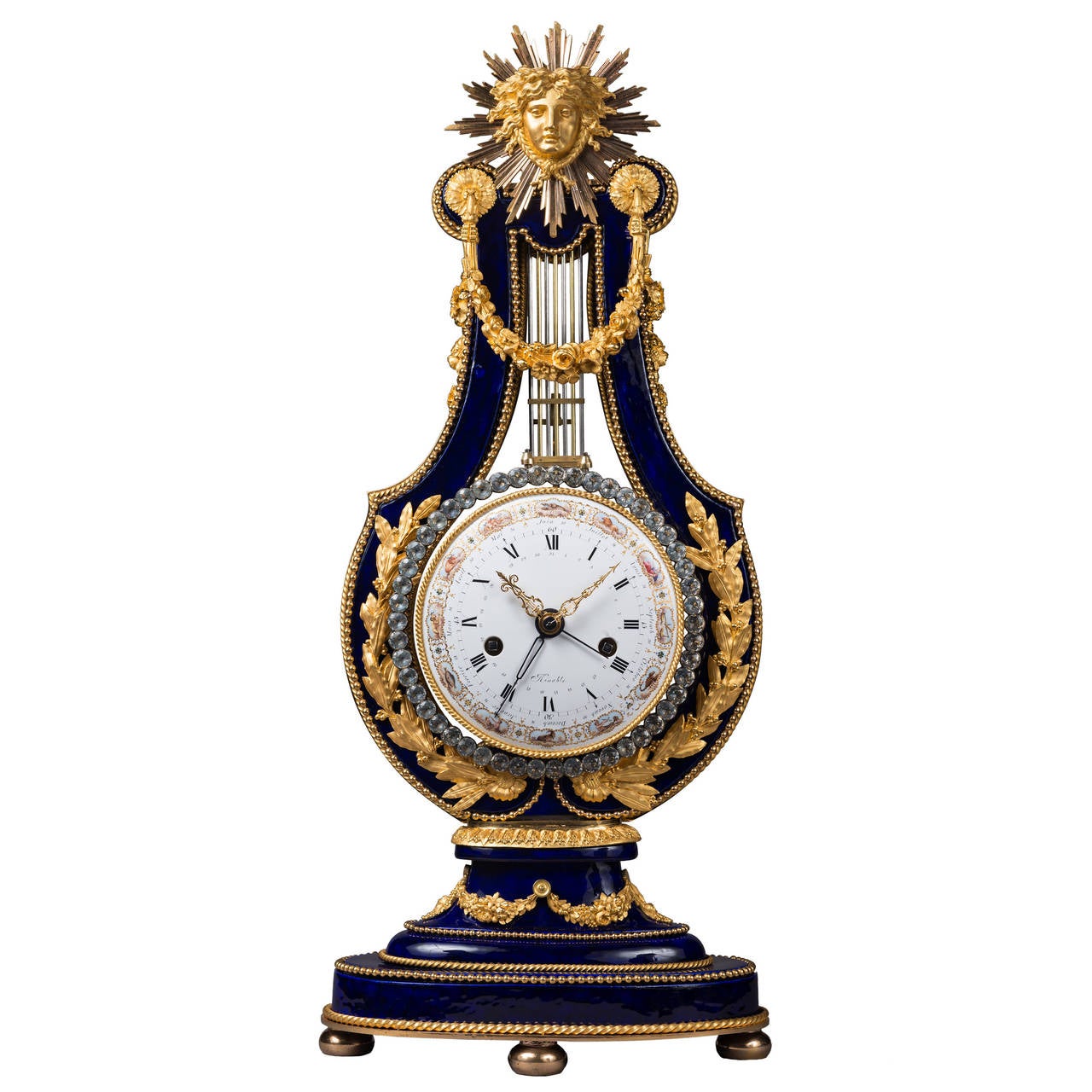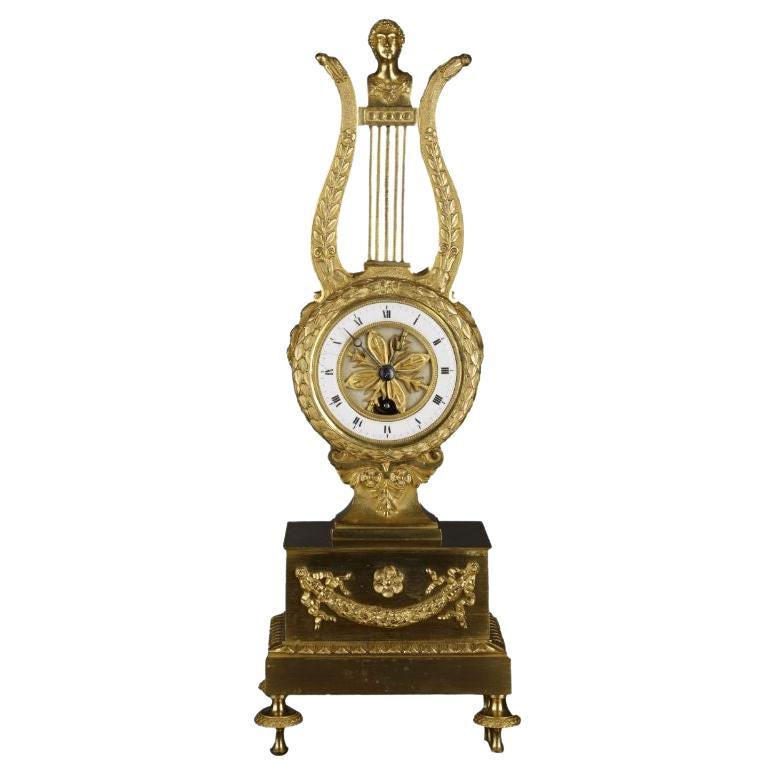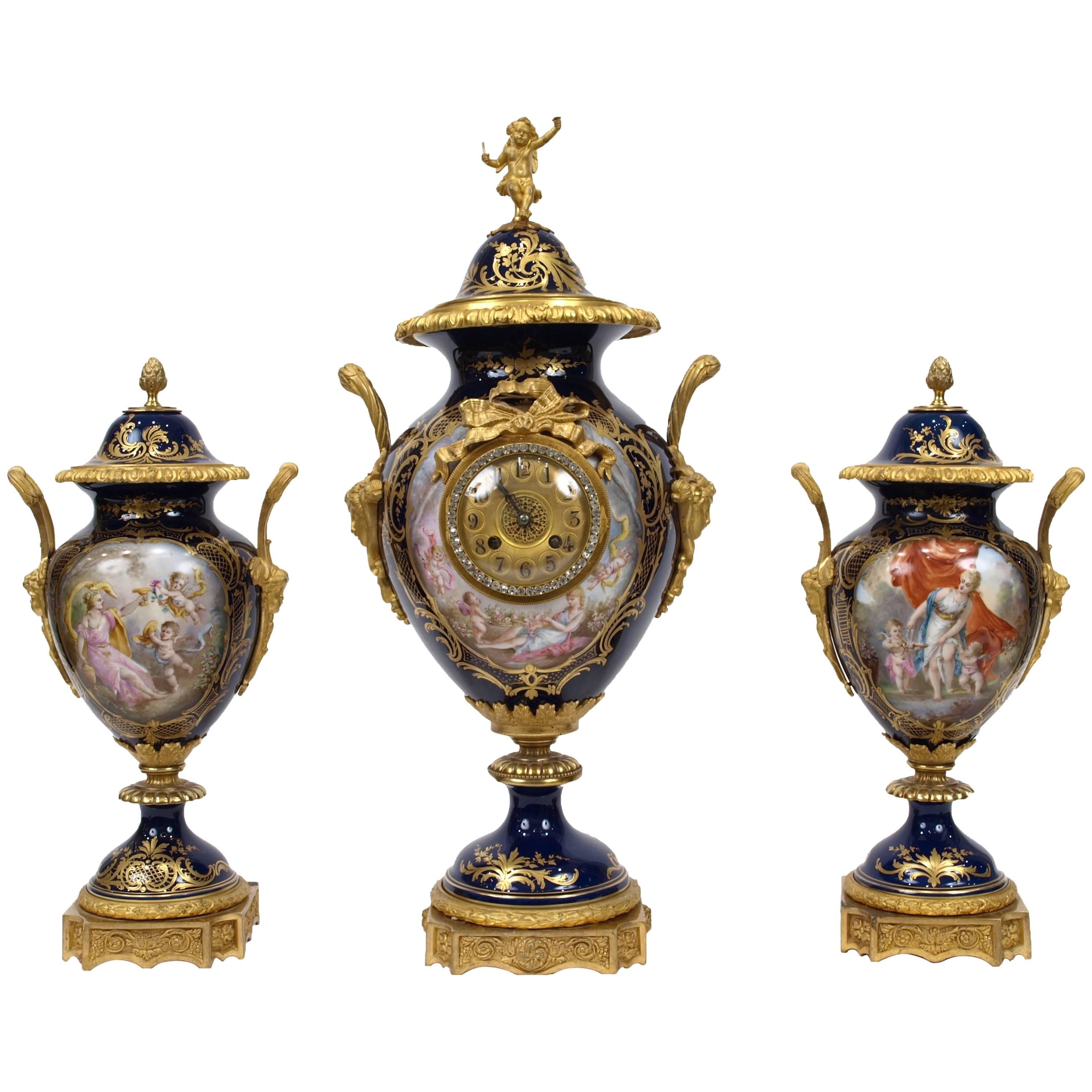c.1820 Very Rare Ormolu and ‘bleu turquoise’ Porcelain Lyre Clock
About the Item
- Creator:Dieudonné Kinable (Clockmaker),Manufacture Nationale de Sèvres (Maker)
- Dimensions:Height: 23.5 in (59.69 cm)Width: 10 in (25.4 cm)Depth: 6 in (15.24 cm)
- Materials and Techniques:
- Place of Origin:
- Period:
- Date of Manufacture:circa 1820
- Condition:Wear consistent with age and use. some slight hairlines to the dial.
- Seller Location:Greenlawn, NY
- Reference Number:
Manufacture Nationale de Sèvres
A maker of exemplary European ceramics for hundreds of years, Manufacture Nationale de Sèvres has produced porcelain of the highest quality since 1740.
The factory enjoyed royal patronage from its earliest days, and its most prominent patrons in the late 1700s — King Louis XV of France and his mistress, Madame de Pompadour — commissioned some of the period’s most elegant and striking pieces (only the truly wealthy could afford porcelain at this time). The company was originally established in Vincennes but was moved at the request of Madame de Pompadour, in 1756, to Sèvres, near Versailles, so that its operations would be closer to her château.
Sèvres became a mighty and much-revered factory working under a special grant from King Louis XV — the company’s owner as of 1759 and whose abundance of orders for special state gifts put financial strain on the company. Madame de Pompadour is said to have commissioned Sèvres to create an entire indoor garden of porcelain botanicals, for example.
While Sèvres gained a sterling reputation for its soft-paste porcelain wares, the company was late in entering into the production of hard-paste porcelain.
Hard-paste porcelain is the most common type of Chinese porcelain, then a widely exported and profitable product that was not made in Europe until the 18th century. The resources at Sèvres were largely relegated to meeting the demands of Louis XV, and secondly, it did not acquire the secret formula for hard-paste porcelain until 1761. Until it obtained the coveted secrets behind hard-paste porcelain from a chemist named Pierre-Antoine Hannong — and, years later, gained access to the elusive raw materials to make hard-paste porcelain — Sèvres produced soft-paste porcelain for decades that was widely celebrated but is comparatively a far weaker type as opposed to the hard-paste productions of the company’s rival, Meissen, in Saxony, the first to produce true porcelain outside of Asia.
The artisans at Sèvres applied the rarest and most difficult-to-produce colors to their decorative objects and dinner services. One such color, the bright bleu de roi, became the manufacturer’s signature shade and is found on many of their objects. Sèvres also experimented with rarely glazed or unglazed works that bore no decoration at all — bisque porcelain, French for “biscuit,” refers to unadorned white porcelain sculptures made at Sèvres that resemble white marble after being kiln-fired.
Sèvres marks were applied over the glaze or rendered with cuts by a sharp tool — authentic Sèvres porcelain is most commonly marked with two interlaced Ls that are painted in blue and enclose a third letter. Painters and potters were tasked with affixing marks to record their role in the creation of a particular piece, and as a lot of these artisans’ names are recorded in archival factory materials — and there is also much to be learned at the Sèvres museum — it’s likely that you can accurately identify your Sèvres piece.
Find antique and vintage Manufacture Nationale de Sèvres vases, urns, sculptures and more on 1stDibs.
- ShippingRetrieving quote...Ships From: Greenlawn, NY
- Return PolicyA return for this item may be initiated within 3 days of delivery.
- c.1820 French Ormolu Mantle Clock Depicting OrpheusLocated in Greenlawn, NYCase: The well-cast and finished ormolu case depicts a large male figure, Orpheus, standing on rockwork while leaning on the clock and playing the flute. He is surrounded by severa...Category
Antique Early 19th Century French Empire Mantel Clocks
MaterialsOrmolu
- c.1765 Ormolu and Patinated Horse Clock by LenoirBy Etienne LeNoirLocated in Greenlawn, NYMaker: Etienne Lenoir Case: The ormolu and patinated case features a prancing horse with a finely textured finish, a wellcast snail, scrolling foliage above framing the clock ...Category
Antique Mid-18th Century French Louis XVI Mantel Clocks
MaterialsBronze, Ormolu
- c.1812 English Patinated, Ormolu and Marble Figural Mantle ClockBy Thomas WeeksLocated in Greenlawn, NYMaker: Semaine (Thomas Weeks), clockmaker. Richard Smith, springmaker Merfield, dial enameler. Case: The extremely well-cast and finished patinated bronze and ormolu case de...Category
Antique 1810s English Mantel Clocks
MaterialsMarble, Bronze, Ormolu
- c.1840 English Ormolu Night Clock by John PaceLocated in Greenlawn, NYMaker: John Pace, Bury St. Edmunds. No.155 Case: The heavy cast ormolu case is elaborately decorated with several decorative elements that include aca...Category
Antique Mid-19th Century English Mantel Clocks
MaterialsBronze
- Early Louis XVI French Ormolu Mantle Clock by Leon A ParisLocated in Greenlawn, NYMaker: Leon a Paris Case: The matte and burnished ormolu case has lion busts holding a fabric swag, frets and is decorated with geometric and natural decorative elements. Abov...Category
Antique Mid-18th Century French Louis XVI Mantel Clocks
MaterialsBronze, Ormolu
- Rare Mid-19th Century Alabaster Conical Clock.Located in Greenlawn, NYA beautiful mid-19th century French conical clock with a patinated metal figure of Jason holding the golden fleece. The decorative alabaster case is ad...Category
Antique Mid-19th Century French Mantel Clocks
MaterialsAlabaster, Bronze
- French Sevres Style Porcelain and Ormolu-Mounted Lyre ClockLocated in Brighton, SussexA French Sevres style cobalt blue lyre clock with finely cast ormolu sunburst and floral swagged mounts with jewelled bezel, pretty floral swa...Category
Antique 19th Century French Louis XVI Mantel Clocks
MaterialsOrmolu
- Very Fine and Rare Onyx, Porcelain, Cloisonné Enamel and Ormolu Mantel ClockLocated in London, GBVery fine and rare green onyx, porcelain, cloisonné enamel and ormolu mantel clock French, Late 19th Century Height 64cm, diameter 23cm This beautiful piece is an exceptionally unusual and equally beautiful mantel clock, crafted from a variety of materials, used to showcase an array of superb decorative arts and techniques. Made in France in the late nineteenth century it is formed of green onyx, porcelain (the vase on top), cloisonné enamel and ormolu. The dials are set upon three columns of ormolu, mounted on green onyx, and framed with enamel in red, white, and blue, floral motifs. The dials are adorned with lettering in both French and Spanish, and measure time, temperature, and pressure. An elegant decorative vase mounts the clock, crafted from porcelain, and similarly decorated with enamel elements. Rare in design and even rare in terms of pure quality, it forms a unique antique timepiece...Category
Antique Late 19th Century French Belle Époque Mantel Clocks
MaterialsOnyx, Enamel, Ormolu
- Antique French Ormolu and Sevres Porcelain ClockBy Manufacture Nationale de Sèvres, Louis JapyLocated in Belper, DerbyshireA lovely early antique French ormolu clock by Louis Japy, part of the great Japy clockmaking dynasty. It is of Louis XVI design and mounte...Category
Antique 19th Century French Louis XVI Mantel Clocks
MaterialsOrmolu
- Sèvres Porcelain Louis XVI Lyre Mantel Clock by Kinable, Dial by DubuissonBy Dieudonné Kinable, DubuissonLocated in Paris, FRDieudonné Kinable Enamel Dial Attributed to Dubuisson (1731-1815) Exceptional Porcelain Lyre Mantel Clock from the Royal Sèvres Porcelain Manufactory Paris, late Louis XVI period, circa 1785-1790 Height 62 cm; width 26 cm; depth 16 cm The round enamel dial, signed “Kinable”, indicates the hours in Roman numerals, the fifteen-minute intervals in Arabic numerals, the annual calendar and the signs of the Zodiac, by means of four hands, two of which are made of pierced gilt bronze, the two others in blued steel. The magnificent lyre-shaped case is made of “bleu nouveau” Sèvres porcelain and finely chased and gilt bronze. The bezel is made up of a gilt bronze twisted rope; the pendulum is adorned with brilliant-cut paste stones; the body of the lyre is adorned with gilt bronze beading and with laurel leaf and seed motifs, with two rosettes issuing floral and foliate swags. The clock is surmounted by a mask with radiating sunrays. The spreading foot is decorated with beading and twisted rope motifs and a leafy garland. The en-suite decorated oval base is raised upon four flattened ball feet. The Royal Sèvres Porcelain Factory produced the lyre clock model as of 1785. Four colours were offered: turquoise, green, pink and bleu nouveau. These exceptional clocks were made for the connoisseurs of the time. Louis XVI had a similar clock in his Salon des jeux in Versailles; its dial bore the signature of the clockmaker Courieult (this is almost certainly the example illustrated in P. Verlet, Les bronzes dorés français du XVIIIe siècle, Paris, 1999, p. 41). Kinable, however, was the clockmaker who purchased the greatest number of lyre cases from the factory, and he developed the model in the late 18th century. Among the porcelain lyre clocks signed by this brilliant horologer, one example is in the Victoria & Albert Museum in London (illustrated in H. Ottomeyer and P. Pröschel, Vergoldete Bronzen, Band I, Munich, 1986, p. 252, fig. 4.6.26). A second such clock is in the Royal British Collection (see C. Jagger, Royal Clocks, The British Monarchy & its Timekeepers 1300-1900, 1983, p. 130, fig. 176). Bibliography: M. Gay and A. Lemaire, “Les pendules lyre”, in Bulletin de l’Association nationale des Collectionneurs et Amateurs d’Horlogerie ancienne, Winter 1993, n° 68, p. 5-40. Dieudonné Kinable (active circa 1785-1810) One of the most important Parisian clockmakers of the late 18th century. His shop was located at n° 131 Palais Royal. He purchased a great number of lyre-type porcelain clock cases...Category
Antique 1780s French Louis XVI Mantel Clocks
MaterialsBronze
- French Ormolu Lyre Mantel ClockLocated in Norwich, GBFrench ormolu Lyre clock standing on a stepped rectangular base with acanthus leaf decoration and floral swags resting on four turned and chased toupe feet. Chased garland gilt bezel surrounding a fine enamel dial with Roman numerals and a gilded starburst...Category
Antique 1840s French Mantel Clocks
MaterialsOrmolu
- Antique Clock Garniture with Sèvres Style Porcelain and OrmoluBy Manufacture Nationale de SèvresLocated in London, GBThis fantastic porcelain clock garniture contains three vases, one of which has been mounted with a ormolu clock dial with jewels surrounding it. The vases are decorated in the style of the Sèvres Porcelain manufacturers, with cartouches to the front and back. The panels on the front depict ladies and putti in a landscape, while the reverse sides depict riverbanks. The vases are set on ormolu bases with canted angles, and feature twin ormolu handles which take the form of masks. The central vase is surmounted by an ormolu putti...Category
Antique 19th Century French Rococo Garniture
MaterialsOrmolu






